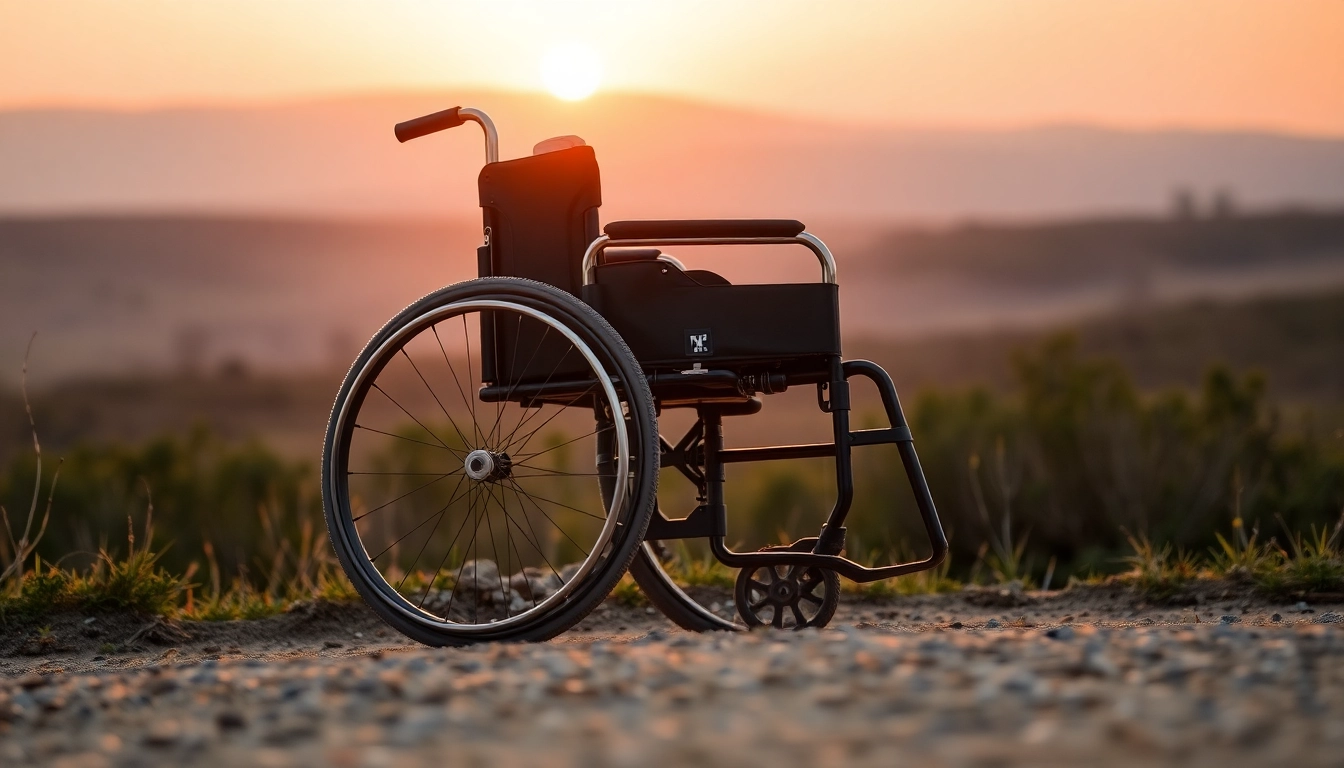Introduction to Manual Wheelchairs
Manual wheelchairs have become an essential mobility aid, facilitating independence for individuals with limited mobility. Unlike powered wheelchairs that rely on batteries, manual wheelchairs are operated by the user or an attendant through pushing the wheels. This article will explore the myriad types and benefits of manual wheelchairs, providing insights on how to select the right model for your needs, and discussing their everyday applications. If you’re looking to enhance mobility, it’s vital to understand the various features and options available in a manual wheelchair.
Understanding Manual Wheelchair Types
Manual wheelchairs can be categorized into several types, each designed to serve specific needs and preferences. Here are the primary categories:
- Standard Wheelchairs: These are typically heavy-duty and are suitable for everyday use. They provide basic functionality without an array of options.
- Lightweight Wheelchairs: Ideal for those who require mobility aids primarily for short distances, lightweight models are easier to maneuver and transport.
- Transport Wheelchairs: Engineered for short trips, these wheelchairs are often pushed by an attendant and are not meant for self-propulsion.
- Reclining Wheelchairs: These offer the ability for the user to recline back, which is beneficial for pressure relief and comfort during long periods of sitting.
- Sports Wheelchairs: Designed specifically for athletic activities, these wheelchairs are optimized for performance and provide stability and speed.
- Custom Wheelchairs: These are tailored to the user’s specific requirements, including adjustments in size, shape, and additional accessories.
Benefits of Manual Wheelchairs
The advantages of using manual wheelchairs are vast, making them a popular choice for many. Some notable benefits include:
- Independence: Users can propel themselves without reliance on batteries or external power, allowing greater freedom and control.
- Cost-Effective: Generally more affordable than electric models, manual wheelchairs also incur fewer maintenance costs.
- Exercise Benefits: Using a manual wheelchair helps promote physical activity, enhancing arm strength and cardiovascular health.
- Variety and Customization: There’s a wide range of options and accessories available, allowing users to tailor their wheelchair for comfort and functionality.
- Accessibility: Manual wheelchairs are generally lighter and easier to maneuver in tight spaces, making them suitable for various environments.
Choosing the Right Manual Wheelchair
Selecting a manual wheelchair can be a nuanced process that requires consideration of individual needs. Key factors to evaluate include:
- Size and Fit: Ensure the wheelchair fits comfortably by considering the seat width, depth, and height. A proper fit can significantly enhance comfort and usability.
- Weight Capacity: Each manual wheelchair comes with a recommended weight limit. It is vital to choose a model that supports the user’s weight plus any additional equipment they may carry.
- Maneuverability: Look for features such as the turning radius and frame design, which can affect how easily the wheelchair can navigate through various spaces.
- Adjustability: Many wheelchairs offer adjustable backrests, footrests, and armrests to optimize comfort both in the short and long term.
Features of Modern Manual Wheelchairs
Modern manual wheelchairs incorporate a range of features that enhance their functionality, comfort, and overall experience for the user. Understanding these features can help potential users make informed decisions.
Frame Materials and Weight Considerations
The materials used in the construction of a wheelchair significantly influence its weight, durability, and usability. Common materials include:
- Steel: Typically heavier and stronger, steel frames are durable, making them suitable for users needing a robust structure.
- Aluminum: Known for being lightweight, aluminum frames are easier to transport and maneuver but may not offer the same durability as steel.
- Carbon Fiber: The newest entrant in wheelchair materials, carbon fiber is extremely lightweight and strong, but often comes at a higher price point.
Seating and Comfort Options
The seating system in a manual wheelchair is crucial for user comfort. Various options include:
- Cushions: Specially designed seat cushions can help in pressure relief and prevent sores, as well as provide overall comfort. Gel, foam, and air cushions are popular choices.
- Back Supports: Options range from basic backrests to more advanced support systems that adapt to the user’s posture and needs over long periods of use.
- Armrests: Adjustable armrests can provide additional support and comfort, especially for those who spend extended periods in their wheelchairs.
Wheel Design and Maneuverability
The design and type of wheels affect the overall performance and usability of a manual wheelchair:
- Wheel Size: Larger wheels can provide a smoother ride over uneven surfaces but may be more challenging to maneuver in tight spaces. Smaller wheels are better suited for indoors.
- Wheel Type: Options include solid, pneumatic, and semi-pneumatic wheels, each catering to different levels of shock absorption and terrain adaptability.
- Suspension Systems: Some models offer advanced suspension systems, providing better shock absorption and comfort during movement.
Maintaining and Caring for Your Manual Wheelchair
Proper maintenance of your manual wheelchair is essential for ensuring its longevity and optimal performance. Regular care can also enhance user safety and comfort.
Regular Maintenance Tips
To keep your wheelchair in top shape, consider the following maintenance tips:
- Inspect Weekly: Conduct a weekly check for any visible damage or wear, especially on the wheels, brakes, and frame.
- Lubricate Moving Parts: Regularly lubricate wheel spokes and joints to prevent rust and ensure smooth movement.
- Check Tire Pressure: If your wheelchair has pneumatic tires, ensure they are properly inflated to the recommended pressure.
Cleaning Your Manual Wheelchair
Regular cleaning not only improves appearance but also enhances functionality. To clean your wheelchair:
- Wipe Down: Use a damp cloth to wipe the frame, wheels, and seat, paying special attention to areas that gather dirt.
- Use Mild Detergents: For deeper cleaning, use mild soap solutions and avoid harsh chemicals that can damage materials.
- Dry Thoroughly: Make sure the chair is completely dry after cleaning to prevent rust and deterioration.
Identifying Repair Needs
Being able to identify potential repair needs can prevent more significant issues down the line. Key signs include:
- Unusual Noises: Grinding or squeaking noises during movement can indicate that the mechanical components need lubrication or adjustment.
- Wobbling Wheels: If wheels wobble or are difficult to turn, it may signify a need for repairs or a replacement.
- Brake Issues: If brakes do not hold firmly when engaged, immediate servicing is required for safety reasons.
Manual Wheelchairs in Everyday Life
Understanding how to effectively utilize manual wheelchairs in various settings enhances user experience and accessibility, promoting a more active lifestyle.
Using Manual Wheelchairs in Different Environments
Manual wheelchairs can be utilized in diverse environments, each presenting unique challenges. Here’s how to manage:
- Home: Ensure that spaces at home are wheelchair-accessible, including ramps for entryways and adequate room for maneuvering furniture.
- Public Places: Many stores and public facilities are equipped with ramps and wider aisles, making navigation easier for wheelchair users.
- Outdoor Settings: Consider terrain when venturing outdoors. Proper wheel selection is essential for maneuvering uneven surfaces like grass or gravel.
Traveling with a Manual Wheelchair
Traveling while using a manual wheelchair can be rewarding but requires careful planning. Here are some tips:
- Check Accessibility: When traveling, always check the accessibility of accommodations and transportation options beforehand.
- Pack Wisely: Bring essential items such as spare parts, tools, and any required medical supplies.
- Use Reclining Features: If you’re traveling long distances, recliners can help alleviate pressure and enhance comfort during travels.
Supported Activities and Sports
Many manual wheelchair users engage in activities that promote physical fitness and social interaction. Here are some popular options:
- Adaptive Sports: Many communities offer adaptive programs for sports like basketball, tennis, and racing.
- Social Events: Participating in community events and support groups can enrich social interactions and provide opportunities for shared experiences.
- Recreational Activities: Wheelchair users are encouraged to engage with nature by exploring outdoor activities such as hiking on accessible trails.
Future Trends in Manual Wheelchair Design
The future of manual wheelchairs is promising, with advancements in technology and design continuously improving user experience. Here are some emerging trends:
Integrating Technology
Innovative technology is transforming manual wheelchair design. Key advancements include:
- Smart Wheelchairs: Some newer models integrate smart technology for enhanced control, navigation aids, and adjustable seating options.
- Health Monitoring: Wearable technologies with real-time health monitoring systems can now sync with wheelchairs to keep track of users’ health metrics.
- App Integration: Mobile applications can assist users in adjusting settings, requesting maintenance, and locating accessible routes.
Feedback from Users and Design Improvements
Manufacturers are increasingly focusing on user feedback for design improvements. This has led to:
- User-Centric Design: Enhanced customization options that reflect individual user preferences and needs.
- Enhanced Comfort Features: Innovations in cushion designs and back support systems based on user experiences.
- Collaboration with Health Professionals: Ongoing dialogue between manufacturers, healthcare providers, and users to create better products.
Innovations in Safety Features
Safety remains a top priority in wheelchair design. Future innovations are aiming to enhance safety through:
- Improved Braking Systems: Advances in brake technology ensure that users have better control, especially on inclines.
- Reflective Materials: Incorporating reflective strips or lights improve visibility during nighttime use.
- Enhanced Stability Features: Designs aimed at preventing tipping and promoting stable seating improve overall user safety.















Leave a Reply